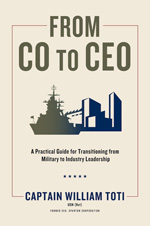 Over the course of my industry career, I’ve become accustomed to hearing a large number of companies brag about the number of military veterans they’ve hired. As a 26-year Navy veteran who later rose to the position of CEO of a defense company, I love to hear this.
Over the course of my industry career, I’ve become accustomed to hearing a large number of companies brag about the number of military veterans they’ve hired. As a 26-year Navy veteran who later rose to the position of CEO of a defense company, I love to hear this.
But I always ask a follow-up question: How many of those veterans are still working for the company five years after they joined? Usually, the leader has no idea.
Here’s a statistic: About 50% of veterans leave their first job within two years of transitioning out of the military. Sometimes it’s because they failed to adapt well to their new company environment and quit. Sometimes they are let go. But I can’t help thinking of the millions of dollars wasted in recruiting, relocating, onboarding and training those new employees, only to have to do it all over again.
The problem is usually that what the company thinks they are getting from the veteran, and what the veteran thinks they are getting from the company, is misaligned from day one. I refer to this condition as “impedance mismatch,” and it wastes both dollars and years when new employees fail to adapt.
How does a company prevent this from happening? It has to start by understanding the differences between hiring a never-served employee and a military veteran.
Veterans bring a great deal of talent to the company if the transition goes well. For example, they’ve likely operated through fairly arduous conditions. Veterans can come to the company with well-developed leadership skills, but, as I like to tell my active-duty friends, “Leadership is hard, but it’s even harder when you’re leading people who can actually quit.” Finally, the veteran has likely changed jobs in the military every two to three years, so they often can learn a new job quickly.
But with those advantages, there are often some disadvantages that the company may have to ameliorate with an appropriate transition training program:
The veteran, particularly officers, may come to the company with an inappropriate degree of hubris as it pertains to their understanding of how to succeed in the corporate world. It’s that “I read a book, saw a movie, got my MBA, so I know how this profit thing works” attitude that can get them in trouble. It’s because of this theory vs. practice difference that I actually discourage veterans from seeking business education post-military. I tell them they can learn everything they need to know about success in their new industry from the company they join.
As implied above, veterans need to understand that leadership techniques that work in the military may not work in industry. A recent Wall Street Journal article talked about companies wanting to hire actual drill sergeants to improve corporate efficiency, but in my view the drill sergeant approach will enforce an unfortunately military stereotype, can lead to an exodus of talent, and is exactly the wrong approach for a company to take.
The company must help the veteran understand its mission. While the military mission, defense of the nation, was self-actualizing, the veteran may suffer from a simplistic notion that in the corporate world the veteran’s only mission is to put more money into his boss’s pocket. Lacking a mission they can really be motivated by, veterans may be less inspired than their never-served counterparts.
And lastly, employers should not assume the veteran knows anything about how business actually works. For example, many of my veteran friends had no understanding of the difference between profit and cash, and therefore often leaned into decisions that appeared profoundly naïve to the business leader. The veteran will likely be able to learn quickly, but she must be given the opportunity to learn.
My frustration with all these matters is why I wrote my book, From CO to CEO: A Practical Guide for Transitioning from Military to Industry Leadership. I believe these insights and tips can go a long way toward helping companies build military onboarding and transition programs that actually work.
 William Toti retired from the Navy in 2006 following 26 years on active duty. He then served 15 years in industry, holding vice president business leadership positions with Raytheon, HP and DXC; president positions with Cubic and L3 Technologies; before serving as CEO of Sparton Corporation. He is the author of the book From CO to CEO: A Practical Guide for Transitioning from Military to Industry Leadership.
William Toti retired from the Navy in 2006 following 26 years on active duty. He then served 15 years in industry, holding vice president business leadership positions with Raytheon, HP and DXC; president positions with Cubic and L3 Technologies; before serving as CEO of Sparton Corporation. He is the author of the book From CO to CEO: A Practical Guide for Transitioning from Military to Industry Leadership.

















